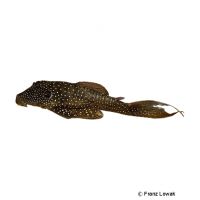L228 (Lasiancistrus sp. 'L228')
| L228 Lasiancistrus sp. 'L228' | |
|---|---|
| Name | L228 |
| Name Lat. | Lasiancistrus sp. 'L228' |
| Family | Suckermouth Armoured Catfishes |
| Family lat. | Loricariidae |
| Order | Catfishes |
| Order lat. | Siluriformes |
| Origin | Peru |
| Habitat | Rivers, streams |
| Diet | Limnivore, soft wood |
| pH | 6.5-7.5 |
| Behavior | Peaceful |
| Keeping | Individual, pair, group |
| Care Level | Moderate |
| Reproduction | Cave spawner |
| Breeding | Difficult |
| Life Span | N/A |
| Protection | No |
| Metric Units | |
| Size | 12-15 cm |
| Temperature | 24-28 °C |
| Hardness | < 15 °dH |
| Aquarium | ~ 200 l |
| US Units | |
| Size | 5"-6" |
| Temperature | 75-82 °F |
| Hardness | < 267 ppm |
| Aquarium | ~ 50 gal |
Distribution and habitat
The Spotted Delta Catfish L228 originate from the catchment area of the Rio Yavari in Peru. They mainly stay in bays of clear, fast-flowing streams with oxygen-rich water between stones and dead wood.
Maintenance
The aquarium should have a robust edge planting with large river pebbles, caves (catfish burrows) and roots that provide hiding places and are also part of the food. A round-grained substrate and a moderately strong current is ideal.
No ammonia, ammonium and nitrite should be detectable, the nitrate value should not exceed 100 mg/l. To ensure the water quality and oxygen content, a filter and heater adapted to the aquarium size is required, as well as lighting for the species-appropriate day-night rhythm of the animals.
Diet
They eat the vegetable cover (growth) of stones, wood, plants, etc. and the microorganisms contained therein. For a balanced diet, feed once a day with a high-quality dry food for loricariid catfish (granules, pellets, chips, tablets), supplemented with algae leaves, soft wood and fresh vegetables, such as zucchini, broccoli, bruised peas or scalded spinach, plus occasional small amounts of zooplankton, cyclops, daphnia, artemia, mosquito larvae, etc. (live or frozen)
Feed only as much as will be eaten within a few minutes, excluding plant foods. Regular and varied feeding promotes health and increases resistance.
Behaviour and compatibility
They are very peaceful and suitable for almost every community aquarium. Within the species they occasionally behave territorially, therefore keeping a group is only recommended in a large, richly structured tank with many hiding places (caves, roots)
Basically, only compatible fish species with similar demands on water quality and water temperature may be socialized.
Sex dimorphism
Sexually mature males have significantly more odontodes (pointed skin teeth), a thickened first pectoral fin ray, and larger pectoral fins than females.
Reproduction and breeding
There are only isolated reports of successful breeding in the aquarium. They are cave breeders and the male does the brood care.
Important
During the day, these excellent algae eaters often stay in caves and shelters
When fishing, use nets with as fine a mesh as possible so that the hard rays of the pectoral fins or the skin teeth (odontodes) do not get caught on the bone plates, which can cause painful puncture wounds when touched.
The well-being of the fish should be checked regularly. Temperature should be checked daily, pH, hardness and nitrate levels at least every 14 days. Regular partial water changes are recommended, even when contaminant levels have not yet reached the upper limit. Sudden changes in water quality should be avoided. Newly introduced fish must be accustomed slowly to the water in the aquarium.
Further literature can be found in your pet store.
References
Text: Werner Winter; Image: Franz Lowak
Source: BMELV (1998): Tierschutzgutachten - Haltung von Zierfischen (Süßwasser); ENGELMANN (2005): Zootierhaltung - Tiere in menschlicher Obhut: Fische, Verlag Harri Deutsch; SCHMIDT, WERNER, LECHNER (2005): MiniAtlas L-Welse, Bede Verlag
- Gemäß § 21 Abs. 5 Tierschutzgesetz idgF
